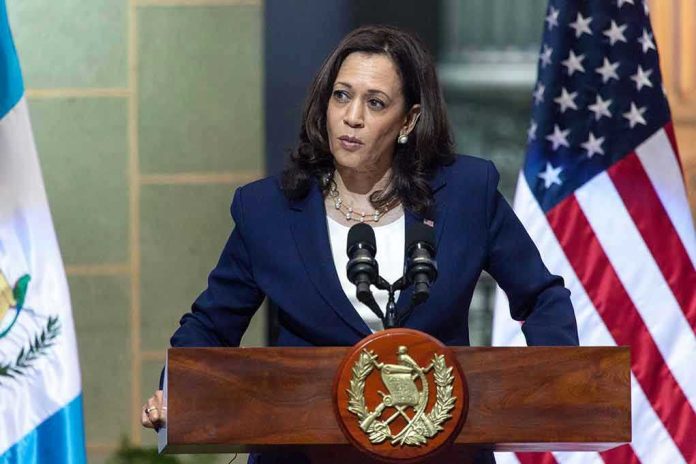
Kamala Harris’s public signal that she might run for president in 2028—just months after a bruising defeat—has Democrats bracing for a leadership battle that could either redefine or unravel the party’s future.
Story Snapshot
- Kamala Harris, the 2024 Democratic nominee, lost to Donald Trump and now hints at a 2028 run, roiling party unity.
- Her memoir and interviews have set off fierce speculation and strategic maneuvering among top Democrats.
- Party insiders warn her potential candidacy could deepen internal divisions and threaten electoral prospects.
- The Democratic field is wide open, with other high-profile figures like Gavin Newsom also eyeing the nomination.
Harris’s 2028 Tease Lights a Fuse Under Democratic Leadership
Kamala Harris’s declaration that she’s “not done” after her 2024 loss has landed like a political thunderclap. While most defeated nominees retreat, Harris is stepping forward, fueling speculation and anxiety. Her new memoir “107 Days” arrived in September 2025, offering a defiant narrative of her campaign and defeat. By October, Harris openly told the BBC and Associated Press that she hasn’t ruled out a 2028 run, sparking a media feeding frenzy and triggering alarm among Democratic strategists scrambling for a new direction.
Democratic insiders now face a dilemma: Harris’s resilience inspires some, but her quick return to the spotlight risks looking like denial, not determination. Her words, “I am not done… service is in my bones,” have become both rallying cry and flashpoint. Party elders privately grumble that her early positioning could freeze other potential candidates and reignite old wounds from the 2024 campaign. The Democratic National Committee, which oversees strategy and candidate selection, finds itself refereeing between party unity and open competition. Meanwhile, the media’s focus on Harris leaves rivals like Gavin Newsom, Andy Beshear, and Alexandria Ocasio-Cortez circling, each weighing the risks and rewards of challenging a recently defeated standard-bearer.
The Party’s Fractured Landscape and the Next Generation Jockeying
Biden’s abrupt exit from the 2024 race left a leadership vacuum and set the stage for Harris’s turbulent campaign. Internal party divisions—over messaging, policy, and leadership style—were exposed and exploited by Trump, whose victory plunged Democrats into another round of soul-searching. Now, the party is in flux, with no clear leader and multiple factions vying for dominance. Harris’s renewed ambitions collide with the push for generational change; her candidacy, if it materializes, could deter fresh faces or trigger a bruising primary fight reminiscent of past Democratic debacles.
Gavin Newsom has publicly flirted with a 2028 bid, telling CBS he’d be “lying otherwise.” His California roots make him both a natural Harris rival and a potential ally, depending on how alliances shift. Other names—Andy Beshear, Ro Khanna, Alexandria Ocasio-Cortez, Bernie Sanders—surface in speculation, but none command the national stature or brand recognition of Harris. The dynamic sets up a high-stakes chessboard, where every move is scrutinized by donors, activists, and media alike. The risk: an extended intraparty fight could leave the party fractured, short on funds, and unprepared to counter a resurgent GOP.
What a Harris Candidacy Would Mean for Democrats—And the Country
Short-term, Harris’s hints at a comeback have deepened Democratic divisions and complicated fundraising for the 2026 midterms. Donors are wary of betting on a candidate with recent national baggage, and activists fear a repeat of 2024’s missteps. Yet, for some, Harris’s persistence is a sign of grit, an opportunity to inspire women and minorities who see her as a symbol of progress. The threat, however, is that her candidacy could reinforce perceptions of Democratic stagnation—unable to move past defeat or offer new leadership in a rapidly changing country.
The broader political industry—consultants, pollsters, media—has already shifted into 2028 mode, anticipating a bruising primary season. Policy debates on climate, healthcare, and the economy will be shaped by the leadership contest, and every candidate’s move will be dissected for signs of momentum or weakness. A drawn-out fight could sap energy and resources, handing Republicans another advantage. At stake is not just the party’s nominee, but the direction of the party itself: will it double down on established names or finally make room for new blood?
Expert Analysis: A Party at a Crossroads
Democratic strategists warn that Harris’s openness to running again could “set a new direction” or just as easily fracture the coalition needed to win. Some analysts praise her resilience, but stress that recent defeat makes her a long shot in a party hungry for change. Political scientists point to historical precedents—Al Gore, Hillary Clinton—and caution against repeating cycles of loss and nostalgia. The consensus among academics and professionals: parties must move past recent losers to thrive, but the allure of a comeback candidate is hard to resist.
Commentators are split. Harris’s supporters see her as a trailblazer, undeterred by setbacks, while critics argue she embodies everything the party needs to move beyond: old battles, old divisions, old narratives. The only certainty is that her decision will shape the landscape for every other contender, forcing the Democratic Party to choose between the comfort of familiarity and the risk—and promise—of renewal.












